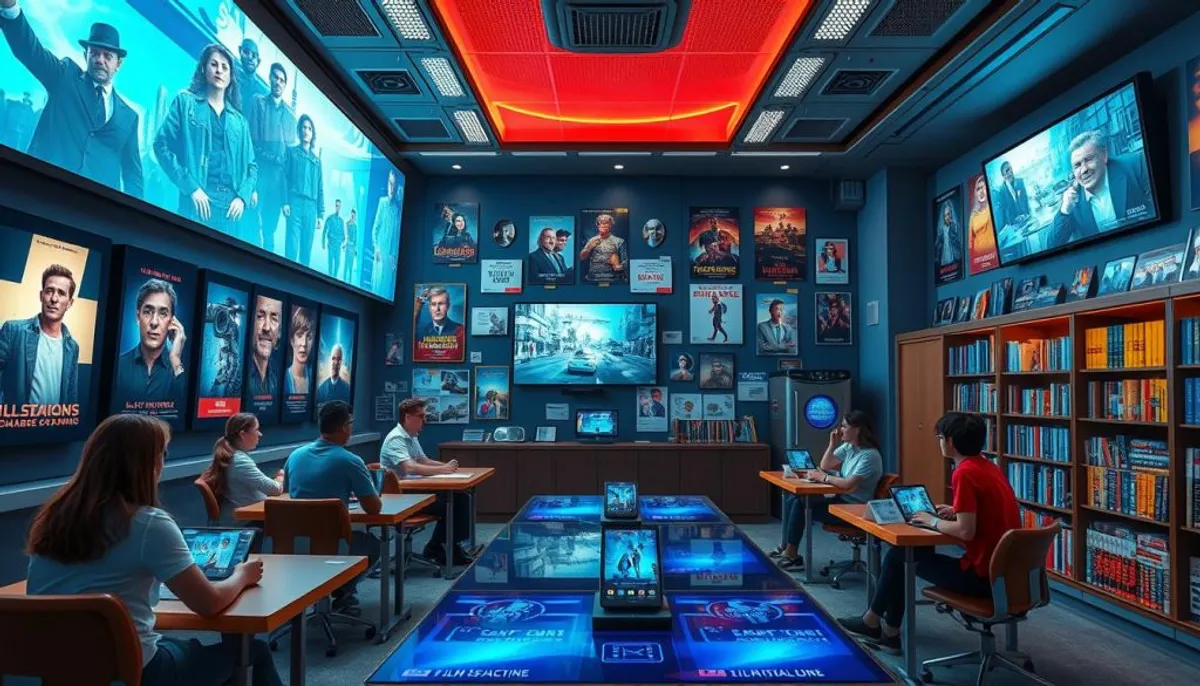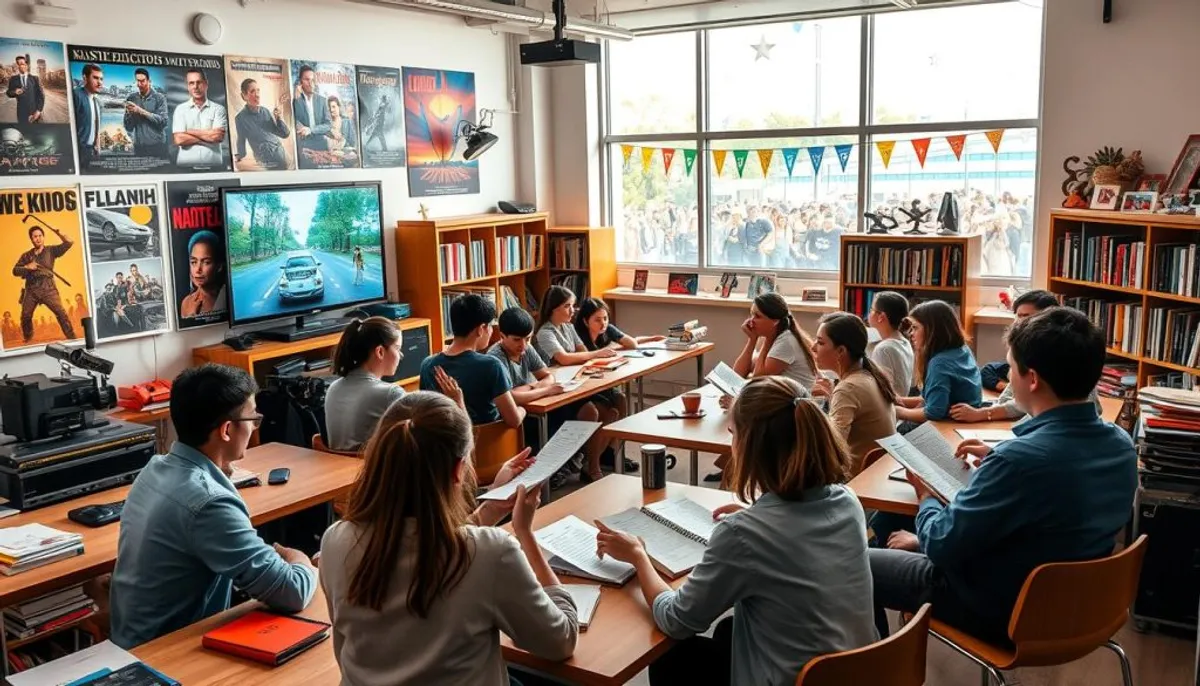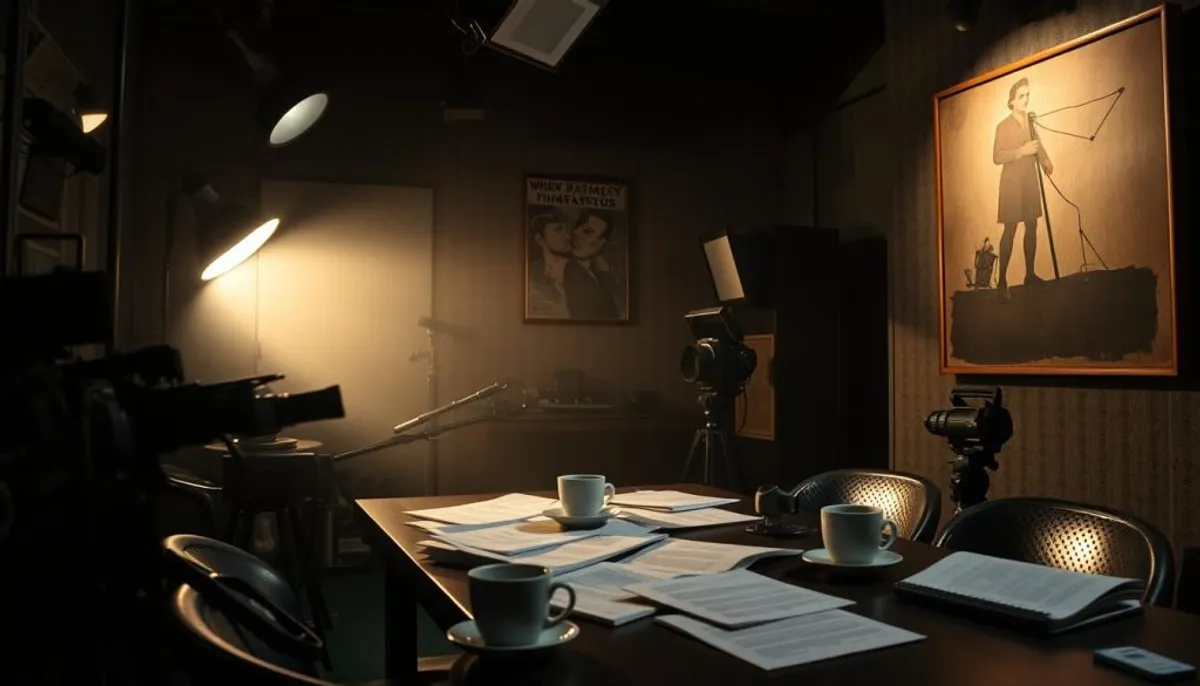The evolution of film education aligns with the transformations of the 7th art. In 2025, possessing a rich film culture requires innovative programs and recent teaching methods.
La Fémis, a renowned institution, offers a program titled “Knowledge, Cultures, Creations.” It aims to broaden students' cinematic perspectives. This course includes museum visits, analysis sessions, and meetings with cinema experts.

To enrich their passion for cinema, students must complete five written tasks. They must also watch a selection of 30 key films. These films, chosen for their role in the history of cinema, are essential for each specialization.
Institutions like Saint-Louis University–Brussels offer master's degrees in film cultures and thoughts. These programs examine the major milestones of cinematic history and the specifics of modern cinema. They significantly enrich students' film culture.
The importance of cinema in our modern society
Contemporary cinema occupies a central place in our society, profoundly influencing our culture and worldview. Its cultural impact resonates in various areas of our lives, from education to the economy. It shapes our daily lives in multiple ways.
The evolution of the 7th art in the digital age
The advent of digital technology has revolutionized the film industry. Streaming has transformed our way of consuming cinema, allowing instant access to a vast selection of films. In 2008, France recorded 186.8 million cinema admissions. This figure has notably evolved with the expansion of digital platforms.
The cultural and educational role of cinema
Education through cinema has become a key element of our educational system. Films are used as teaching tools, introducing students to major literary works, such as “1984” by George Orwell. They stimulate imagination, encourage creativity, and promote an inclusive view of society.
The impact of streaming on our relationship with cinema
Streaming has transformed our way of consuming cinema. It has made a broader range of films from around the world accessible, changing the traditional cinematic experience. However, the collective experience of cinema remains valuable, fostering social interaction and sharing of cultural experiences.
Cinema remains an essential tool for reflecting on our society. It addresses political, social, and existential themes, stimulating dialogue and critical reflection. Its influence extends beyond entertainment, shaping our understanding of the world and ourselves.
Cinematic education initiatives in France
France stands out for its variety of artistic education programs focused on cinema. These initiatives aim to enrich the film culture of young people and encourage their creativity.
The “High School Students and Apprentices in Cinema” program
Involved by the CNC, DRAC, Regions, and academies, this national program allows high school and CFA students to discover a range of cinematic works. In 2023, 279,158 high school students benefited from this enriching experience.

Regional and national initiatives
Various programs are available for all ages. “School and Cinema” has reached 617,671 students, while “Middle School in Cinema” has involved 410,240 middle schoolers. The films offered cover a wide range of genres and nationalities, thus promoting cultural diversity.
The role of DRAC and regional coordinations
The DRAC plays a crucial role in supporting regional coordination and funding certain actions. A regional steering committee, composed of representatives from each body, ensures the follow-up of operations. The regional image education poles, supported by the CNC and DRAC, coordinate local actors and contribute to the development of professionals' skills.
| Program | Number of participating students |
|---|---|
| School and Cinema | 617,671 |
| Middle School in Cinema | 410,240 |
| High School Students and Apprentices in Cinema | 279,158 |
How to have a film culture
Film learning is an exciting adventure through the history of the seventh art. To enrich one's film culture, it is crucial to vary one's knowledge. A study reveals that 78% of cinema enthusiasts consider famous quotes essential to their film culture.
Film analysis is essential in this learning. It helps to grasp the techniques of directors and appreciate the details of their works. 85% of enthusiasts emphasize the importance of music in cinema, showing the significance of knowing notable soundtracks.
To broaden one's film culture, it is advisable to discover films from various periods and genres. A thoughtful selection could include: gift voucher offers bimpli that allow access to exclusive screenings.
- A western by John Ford (1956)
- A war film by Stanley Kubrick
- A contemporary award-winning work like “Parasite” by Bong Joon-ho
These films, covering the period from 1956 to 2019, offer a rich insight into the history of cinema. They address various themes, such as justice, social inequalities, and ethics, which are essential for a deep understanding of cinematic art.
By exploring these diverse works, one develops a critical eye. One immerses oneself in the fascinating world of cinema, the foundation of a true film culture.
The discovery of different cinematic genres
Cinema presents a variety of cinematic genres. In France, the sector attracted 181 million spectators in 2023. Among them, 40% opted for French productions. This diversity allows for the exploration of varied universes, from drama to comedy to science fiction.
Author cinema and art house films
Author cinema plays a crucial role in French cinema. These works, often screened in Art & Essai classified theaters, represent about 60% of cinemas participating in the Cinema Advantage program. This genre offers a unique and personal vision of the director, encouraging reflection and critical analysis.

Classics of world cinema
Classics of cinema play a major educational role. They allow exploration of the history and culture of countries through adaptations of literary works or historical films. For example, films like “Gandhi” or “Queen Margot” offer a fascinating insight into important historical periods and figures.
New trends in contemporary cinema
Contemporary cinema is constantly evolving, reflecting current societal concerns. Teenagers aged 15-19 are the biggest consumers of cinema, with an average of 12 visits per year. This generation influences new trends, fostering the emergence of innovative genres and original narratives that redefine the cinematic experience.
Digital resources to deepen knowledge
The digital world proves to be a goldmine for enriching one's knowledge of cinema. Cinema enthusiasts can access a variety of digital tools. These tools range from mobile applications to online platforms dedicated to film analysis.
“Cultural Coach” is an essential application, offering over 3,000 questions about cinema and other cultural fields. “Google Arts & Culture” allows virtual exploration of over 2,000 museums and art galleries. This provides valuable artistic context to grasp the evolution of cinema.
Specialized platforms like “Transmitting Cinema” and “The Thread of Images” provide educational files and student sheets in digital format. These resources are crucial for online film analysis. They allow enthusiasts to deepen their understanding of cinematic works.
| Application | Main feature | Number of items |
|---|---|---|
| Cultural Coach | Culture questions | 3,000+ |
| Google Arts & Culture | Virtual visits | 2,000+ places |
| On this day | Daily historical events | Since antiquity |
| Star Walk 2 | Astronomical information | Real-time |
The educational videos “My Class at the Cinema” provide insight into film production and cinema professions. These varied digital resources allow everyone to develop their film culture at their own pace. They adapt to all interests.
The importance of cinemas in learning
Cinemas are essential for film education. They offer a deep immersion, indispensable for developing a true film culture. This immersion is crucial for understanding the 7th art.
The unique experience of cinema screenings
Screenings in theaters offer total immersion in the work. A giant screen, immersive sound, and complete darkness create the ideal atmosphere for concentration. This collective experience fosters exchanges and discussions post-film, thus enriching the analysis.
Film festivals and events
Film festivals are privileged places to discover new talents and artistic movements. They offer the opportunity to see films in advance and participate in exciting debates. The Cannes Film Festival, for example, attracts thousands of film lovers and professionals from around the world each year, supported by cultural grants.
Meetings with cinema professionals
Cinemas regularly organize professional meetings with directors, actors, or technicians. These exchanges are valuable for understanding the behind-the-scenes of cinema and drawing inspiration from the paths of these professionals. They also allow for the discovery of the various professions in the sector.
Learning about cinema therefore involves regular visits to the dark rooms. It is there that a true film culture is forged, combining the pleasure of discovery with a deep understanding of the medium.
Developing critical and analytical thinking
Film analysis plays a crucial role in forming a rich film culture. In 2025, the emergence of innovative teaching tools has opened new avenues for cinema enthusiasts. These tools allow for an in-depth exploration of the seventh art.
Film analysis tools
Film analysis methods are at the heart of cinema-audiovisual education. Students learn to break down films according to five dimensions: emotions, motifs, representation, writing, and technique. This approach fosters the development of analytical and reflective skills, crucial for informed film criticism.
Reading critiques and essays
Reading critiques and essays is essential for refining one's thinking. Works like “The Vitelloni” by Fellini and “High School” by Wiseman, included in the 2024-2025 program, are perfect examples. These readings allow for comparison of one's own analyses with those of experts, thus improving critical judgment.
Participation in film clubs
Film clubs create a conducive environment for discussion. In a context where audiovisual is evolving towards dematerialization, these meeting places are valuable. They allow for exchanges on cinematic innovations. It is a perfect opportunity to share analyses and sharpen critical thinking in the face of transformations in the audiovisual sector.
RelatedRelated articles


